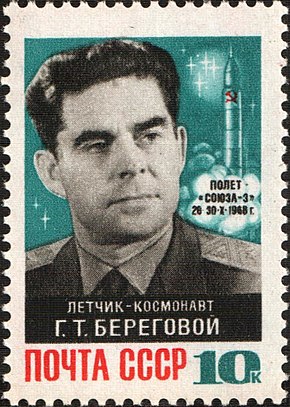 Soyuz 3 commemorative postage stamp, USSR, 1968 | |
| Mission type | Test flight |
|---|---|
| Operator | Soviet space program |
| COSPAR ID | 1968-094A |
| SATCAT no. | 03516 |
| Mission duration | 3 days 22 hours 50 minutes 45 seconds |
| Orbits completed | 81 |
| Spacecraft properties | |
| Spacecraft | Soyuz 7K-OK No.10 |
| Spacecraft type | Soyuz 7K-OK (active) |
| Manufacturer | Experimental Design Bureau (OKB-1) |
| Launch mass | 6575 kg |
| Landing mass | 2800 kg |
| Dimensions | 7.13 m long 2.72 m wide |
| Crew | |
| Crew size | 1 |
| Members | Georgy Beregovoy |
| Callsign | Аргон (Argon - "Argon") |
| Start of mission | |
| Launch date | 26 October 1968, 08:34:18 GMT |
| Rocket | Soyuz |
| Launch site | Baikonur, Site 31/6[1] |
| End of mission | |
| Landing date | 30 October 1968, 07:25:03 GMT |
| Landing site | Karaganda, Kazakhstan |
| Orbital parameters | |
| Reference system | Geocentric orbit[2] |
| Regime | Low Earth orbit |
| Perigee altitude | 196.0 km |
| Apogee altitude | 241.0 km |
| Inclination | 51.66° |
| Period | 88.87 minutes |
 Soyuz 3 mission patch | |
Soyuz 3 (Russian: Союз 3, Union 3) was a spaceflight mission launched by the Soviet Union on 26 October 1968. Flown by Georgy Beregovoy, the Soyuz 7K-OK spacecraft completed 81 orbits over four days. The 47-year-old Beregovoy was a decorated World War II flying ace and the oldest person to go into orbit up to that time. The mission achieved the first Russian space rendezvous with the uncrewed Soyuz 2, but failed to achieve a planned docking of the two craft.
- ^ Wade, Mark (2016). "Baikonur LC31". Astronautix.com. Archived from the original on 20 August 2016. Retrieved 14 July 2016.
- ^ Cite error: The named reference
Trajectorywas invoked but never defined (see the help page).